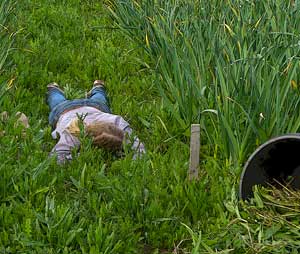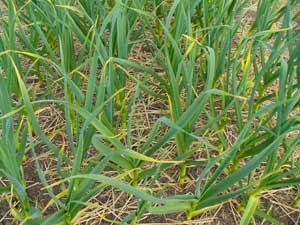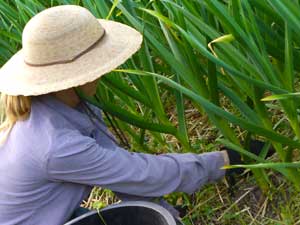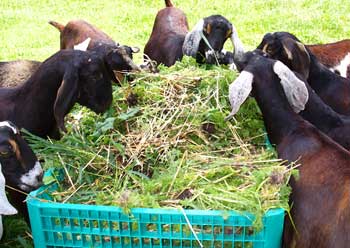Sustainable Practices: Benefits of growing sustainably
Organic Weed Control: Removing Weeds the Grey Duck Garlic Way
Controlling weeds organically can be done the smart way or the hard way. Since we have done it both ways you can learn from our experience! Just to be fair we'll outline both methods.
Controlling Weeds the Hard Way:
1) Plant garlic and 'forget' to mulch.
2) Do not bother to control small weeds because 'they are not too bad yet' and 'a little competition is good for the crop.'
Picture: Weeds can quickly overwhelm a tired garlic farmer! Try to keep up to avoid being overcome by a sea of green.
3) Look out and see that weeds are towering over garlic ... use several words that your 4 year old immediately picks up on and starts using in front of grandma.
4) Either: weed until your hand bleeds, your back aches and your 4 year old forgets who you are and starts calling you, "that grumpy person who smells like garlic." OR do not weed because, after all, weeds are natural, and end up harvesting garlic bulbs the size of small grapes.
5) Either way, vow to never plant garlic again.
Controlling Weeds the Easy and Smart Way: Five fun tips on how to minimize weeds without breaking your back:
1) Mulch your field. Mulch protects the plant in the winter and stifles weed growth in the spring. 
Picture: Weed free hardneck garlic.
2) Get on top of weeds early in the spring. Don’t wait until weeds are a foot high to start controlling them or you will be breaking your back all summer.
3) Try out a wheel hoe. We used a wheel hoe to control weeds in the aisles. This device worked GREAT! Once you get the hang of using the wheel hoe, it is amazingly easy to control small to medium weeds. One swipe uproots weeds and leaves them to die in the sun. It is fairly fast (much quicker than a regular hoe) to go around beds.
Two wheel hoe tips: 1) If you are having problems make sure the handles are the right length for you. We had to adjust our handles down to women size by making them shorter. Once the handles were right it made a great weed removal tool. 2) Sharpen the hoe blades for the best experience.
4) Rotate your garlic and use a cover crop to smother out weeds. If you have a bad weed problem, make sure to turn over your cover crop before the weeds bloom. Speaking of weed problem, don't let your cover crop bloom and set seeds or you will have more weeds that look a lot like your cover crop.
Picture: Patty takes care of small weeds before they can grow into towering pillars.
5) Don’t let patches of noxious weeds spread. Try extreme measures on really bad weed spots; like black plastic on top to kill weeds, putting down extremely heavy mulch or paying enthusiastic kids per weed with root. Plastic works quickly on even the toughest weeds. Flame weeders can be satisfying to use but it doesn't kill perennial weeds without repeat applications. It works great on small weed though.
Long term sustainable methods reduce weed growth over time:
1) Enlist your farm animals in the war against weeds. Our cows don’t roam in our garlic field but they do keep down weeds in their pasture which is next to the garlic plots. We have found that weeds don’t respect fence lines. Rhizomes and seeds readily cross over to our growing areas.
 Picture: Nubian goats chow down on a wagonload of weeds.
Picture: Nubian goats chow down on a wagonload of weeds.
Unlike most goats, cows don’t naturally eat thistles and weeds unless they are taught to do so by a friendly rancher or their Mama. For a story about how to get cows to eat weeds see Women vs. Weeds. For tips on how to train your cows to eat Canada thistle see Training Your Cow to Eat Weeds. Weeds are a great nutrient source for your grass munching friends. Canada thistles are equal to young alfalfa in nutritional content.
2) Try to have zero tolerance for weeds going to seed. One Canada thistle can have over 1,500 seeds and 90% of these seeds can germination within the next year. Even if weeds get away from you, remove the flower buds by cutting or mowing. Consider the time spent removing one seed head in the fall versus trying to dig up hundreds of new weed seedlings the next spring.
3) Control weeds on the edges of your growing areas; these weeds drift into your plot.
4) Plant non-invasive and native plants to displace and out-compete weeds. Weeds usually come in to fill a vacuum on disturbed soil.
5) As you control weeds, weed seeds in the soil will be slowly depleted. This will result in fewer weeds over time. I once talked to a farmer in his mid-80’s who had several hundred acres of wheat he had hand weeded for years. His wheat had no weeds in it at all. He told me he just had to walk the field edges to make sure weeds didn't sneak in from the neighbor's fields. I really wanted to adopt this guy as my grandpa and let him loose in my field!
